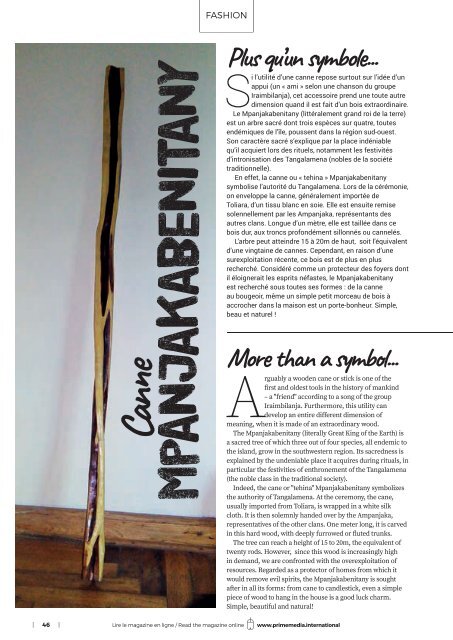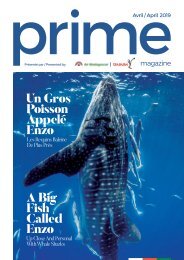PRIME MAG - AIR MAD - MAY 2018 -all FINAL
Create successful ePaper yourself
Turn your PDF publications into a flip-book with our unique Google optimized e-Paper software.
FASHION<br />
Canne<br />
Mpanjakabenitany<br />
Plus qu’un symbole...<br />
Si l’utilité d’une canne repose surtout sur l’idée d’un<br />
appui (un « ami » selon une chanson du groupe<br />
Iraimbilanja), cet accessoire prend une toute autre<br />
dimension quand il est fait d’un bois extraordinaire.<br />
Le Mpanjakabenitany (littéralement grand roi de la terre)<br />
est un arbre sacré dont trois espèces sur quatre, toutes<br />
endémiques de l’île, poussent dans la région sud-ouest.<br />
Son caractère sacré s’explique par la place indéniable<br />
qu’il acquiert lors des rituels, notamment les festivités<br />
d’intronisation des Tangalamena (nobles de la société<br />
traditionnelle).<br />
En effet, la canne ou « tehina » Mpanjakabenitany<br />
symbolise l’autorité du Tangalamena. Lors de la cérémonie,<br />
on enveloppe la canne, généralement importée de<br />
Toliara, d’un tissu blanc en soie. Elle est ensuite remise<br />
solennellement par les Ampanjaka, représentants des<br />
autres clans. Longue d’un mètre, elle est taillée dans ce<br />
bois dur, aux troncs profondément sillonnés ou cannelés.<br />
L’arbre peut atteindre 15 à 20m de haut, soit l’équivalent<br />
d’une vingtaine de cannes. Cependant, en raison d’une<br />
surexploitation récente, ce bois est de plus en plus<br />
recherché. Considéré comme un protecteur des foyers dont<br />
il éloignerait les esprits néfastes, le Mpanjakabenitany<br />
est recherché sous toutes ses formes : de la canne<br />
au bougeoir, même un simple petit morceau de bois à<br />
accrocher dans la maison est un porte-bonheur. Simple,<br />
beau et naturel !<br />
More than a symbol...<br />
Arguably a wooden cane or stick is one of the<br />
first and oldest tools in the history of mankind<br />
– a "friend" according to a song of the group<br />
Iraimbilanja. Furthermore, this utility can<br />
develop an entire different dimension of<br />
meaning, when it is made of an extraordinary wood.<br />
The Mpanjakabenitany (liter<strong>all</strong>y Great King of the Earth) is<br />
a sacred tree of which three out of four species, <strong>all</strong> endemic to<br />
the island, grow in the southwestern region. Its sacredness is<br />
explained by the undeniable place it acquires during rituals, in<br />
particular the festivities of enthronement of the Tangalamena<br />
(the noble class in the traditional society).<br />
Indeed, the cane or "tehina" Mpanjakabenitany symbolizes<br />
the authority of Tangalamena. At the ceremony, the cane,<br />
usu<strong>all</strong>y imported from Toliara, is wrapped in a white silk<br />
cloth. It is then solemnly handed over by the Ampanjaka,<br />
representatives of the other clans. One meter long, it is carved<br />
in this hard wood, with deeply furrowed or fluted trunks.<br />
The tree can reach a height of 15 to 20m, the equivalent of<br />
twenty rods. However, since this wood is increasingly high<br />
in demand, we are confronted with the overexploitation of<br />
resources. Regarded as a protector of homes from which it<br />
would remove evil spirits, the Mpanjakabenitany is sought<br />
after in <strong>all</strong> its forms from cane to candlestick, even a simple<br />
piece of wood to hang in the house is a good luck charm.<br />
Simple, beautiful and natural!<br />
| 46 | Lire le magazine en ligne / Read the magazine online www.primemedia.international















